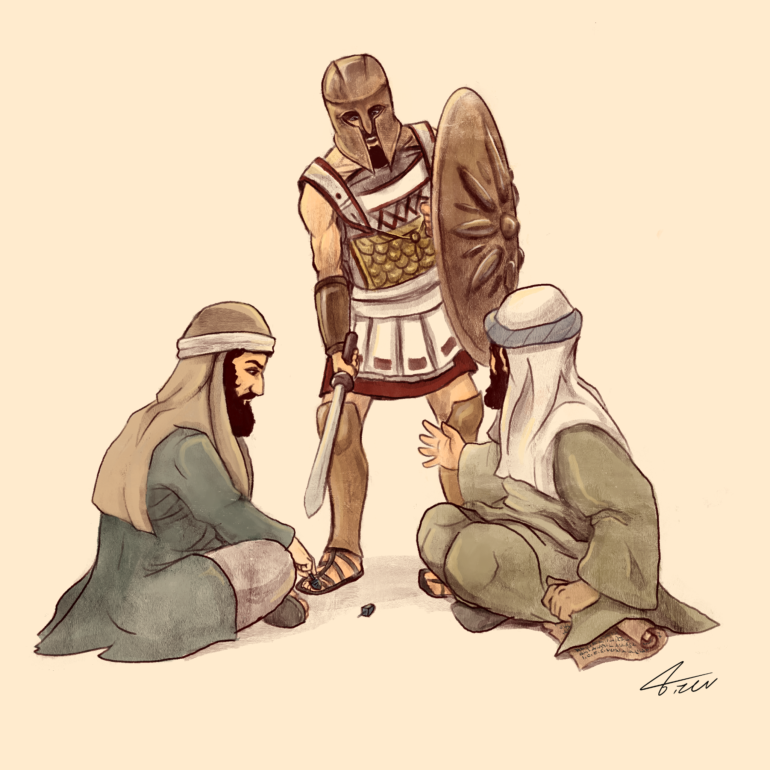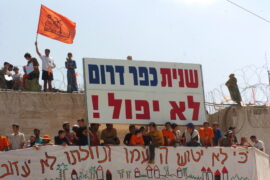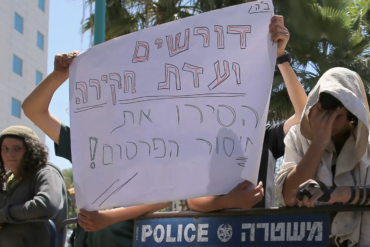The introduction to a podcast series on the first Book of Maccabees.
For more content from VISION Magazine, subscribe to our newsletter and follow us on Twitter @VISION_Mag_, Facebook and YouTube. If you haven’t already, don’t forget to subscribe to our podcast on SoundCloud, iTunes, Stitcher, TuneIn, or Spotify and leave a rating and review to help us get our message out to a wider audience!
To support the podcast, head over to our PayPal portal and be sure to write a note that your contribution is for the podcast.
Hosted by: Robert Goodman
Transcript:
Shalom Aleikhem one and all, and welcome to this series of shiurim on the book of Maccabees! Now I think it’s fair to say that in elementary school they don’t teach us the full story of Ḥanukah. Any Jewish schoolchild can tell you the story of how the nasty Greeks wouldn’t let us keep the Torah, so the heroic Maccabees rose up and fought against them. Then they found a pure jug of oil that contained only enough oil for one day, and instead of one day it lasted for eight days.
End of story? No way!
The story of the Maccabean revolt against the Greek empire is arguably one of the most incredible chapters of Jewish history, where a small band of a few thousand Jewish warriors engaged one of the greatest empires in world history in a 26-year war for freedom – and came out victorious. It’s an incredibly powerful tale and one that sadly many often learn only on a superficial level, not realising how it fits against the backdrop of world history and the true significance of the war.
So let’s get straight into it. We’ll be learning the Ḥanukah story like you never learned it before. We’ll be learning how Yehuda HaMaccabi, leader of the revolt, slays the Greek generals Apollonius and Nikanor, how Yonatan his brother gets ambushed in the city of Akko, how the miracle of the oil fits into it all and how five brothers are able to lead their people through an entire generation of battles and not only succeed in restoring Jewish sovereignty over Judea but add several new holidays to the Hebrew calendar in the process.
I’ll be using a copy of the text, which can be found on the online Jewish library Sefaria, for anyone interested, under “Second Temple” “Book of Maccabees I” – although the English is based on a Christian translation and therefore is not 100% accurate. If you want to read through the text for yourself it’s good enough to use, but if you want a more reliable translation, I recommend that you manually translate the Hebrew for yourselves as you go. As for me, whenever I’ve quoted a verse from the text I’ve tried to translate it manually. I’ll be using Josephus, the other chief source from who we know the details of the Maccabean revolt. Flavius Josephus, or Yosef ben Matityahu, worked for the Roman emperor Vespasian in chronicling the details of the Roman-Jewish war which culminated in the destruction of the second Beit HaMikdash. But he also wrote a twenty volume complete history of the Jews from creation up to the start of the revolt against Rome, which he called “The Antiquities of the Jews” or more simply “Antiquities.” This complete chronicle of Jewish history contains details of the entire revolt and fills in countless details not included in the books of Maccabees, and is an indispensable resource to anyone wanting to learn about this period of Jewish history. I’ll also be including a lot of material I learned from my teacher, Rabbi Yehuda HaKohen, an expert on the Maccabean revolt and my inspiration for this entire project, as well as material from a book entitled A Crash Course in Jewish History, by Rabbi Ken Spiro of Yeshivat Aish HaTorah – a book which taught me so much about Jewish history and one I highly, highly recommend reading.
I hope you’re excited to begin, because I know I am!
Just before we go any further, a brief disclaimer: when preparing this I’ve tried to ensure all the information here is as accurate as possible, but there’s still a chance that throughout this podcast I may quote a piece of information inaccurately. If anyone picks up on something I have gotten wrong, please get in touch and I will endeavor to include the corrections in the next episode.
So before we begin learning the book of Maccabees itself, there’s a few things we need to clarify. First of all, there is a difference of opinion between Jewish and Christian scholars as to when the revolt actually took place. Christian scholars say it began in the year 3596 after the creation of Adam HaRishon (which for them, or anyone else who insists on using the Christian dating system, comes out as 164 BCE). Jewish scholars, on the other hand, hold it began nearly thirty years later in the year 3622 (which is 138 BCE). Rabbi Spiro also explains, by the way, that this is the reason why there seems to be a 164 year gap in Jewish history; it’s down to the discrepancy between Christian and Jewish dating. For example, Christians dated the first Beit HaMikdash as having been destroyed in 586 BCE, while the Jewish dating Sefer Seder Olam dates it to 422 BCE. The discrepancy arose because the Christian scholars miscalculated how long the Persian Empire lasted and added in more than a hundred years. Needless to say in these recordings I’ll be using the Jewish dates, both because I’m heavily biased and also because the Jewish dating system is infinitely more accurate, which quickly becomes apparent to anyone who looks at how much the Gregorian calendar has been tampered with over the centuries.
The second thing we need to clarify is if this is only the first book of Maccabees, then how many books are there, and learn this one in particular? The answer is that in total there are four book of Maccabees, but the 3rd and 4th are part of the Christian New Testament, so we don’t care about those. The second book was originally written in Greek and was based on an earlier work by the ancient historian Jason of Cyrene; it’s a useful source of information and I will be referencing it. The first book of Maccabees, however, was originally written in Hebrew as an official history of the Hasmonean kingdom after the final Jewish victory, though we don’t know exactly who wrote it. Also, the first book takes us through the entire revolt from beginning to end, whereas the second book stops halfway through. Therefore, in this shiur we’ll be focusing mainly on the first book of Maccabees.
We also need to appreciate where the Maccabean revolt falls in relation to Jewish history as a whole, so the rest of this introduction will be devoted to an overview of Jewish history from Yetziat Mitzrayim up until the events at the start of the book of Maccabees. After Bnei Yisrael leave Egypt amid vast miracles, receive the Torah from HaShem at Mount Sinai, make a golden calf and wander around the Sinai Peninsula for forty years, we finally enter Eretz Yisrael under the command of Moshe Rabbeinu’s chief disciple Yehoshua Bin Nun. Once we enter the land, we remain there for a total of 850 years. (A good way to remember this is from a pasuk in V’et’ḥanan which we lein at shaḥrit on Tisha B’av: the word “ונושנתם “from “ונושנתם בארץ” – “and you will have dwelled long in the land” – has a gematria (numerical value) of 852. If we had remained in the land for 852 years our sins would have caused our resulting exile to become permanent, but HaShem in his mercy exiled us two years early so that our absence from the land would only remain temporary.)
The first 400 or so years of these 850 are known as the era of the Shoftim, the Judges, and are marked by repeated cycles of a small portion of Bnei Yisrael succumbing to idolatry, the nation falling into their enemies’ hands, crying out to HaShem and being miraculously saved through a shofet. Then there would be peace in the land for as long as the shofet lived, but when he or she died, the cycle would begin again. Key events from this time period include Dvora HaNevia’s miraculous victory against the Canaanite general Sisra, Gideon ben Yoash taking his soldiers down to the water to test who were worthy enough to battle Midian, the story of Megillat Ruth where the legacy of a widow named Naomi is perpetuated through the righteous Boaz (whom the G’mara in Bava Batra identifies as the shofet Ivtzan), and Shimshon ben Manoaḥ collapsing a building on himself and thousands of Plishtim.
After all this, the people request that the final shofet, Shmuel ben Ḥana, establish for them a monarchy – and this is the system of government that remains in place until the destruction of the first Beit HaMikdash. Among the first Hebrew kings were David ben Yishai, who conquered Yerushalayim from the Yevusim, and his son Shlomo, who built the first Beit HaMikdash there in the year 2928 from creation, 480 years exactly after Bnei Yisrael left Egypt. The times when David and Shlomo reigned were a period of unique peace and prosperity for our people – but after Shlomo’s death, the kingdom split in two, with the kingdom of Israel in the north ruled by a king from shevet Ephraim, and the kingdom of Yehuda in the south, ruled by a descendant of David HaMelekh, from shevet Yehuda. The northern kingdom quickly succumbed to idolatry and its inhabitants were exiled by the Assyrians in the year 3205. The southern kingdom was not so steeped in idolatry, but eventually it too succumbed and the Babylonians, led by King Nevukhadnezzar, burned the first Beit HaMikdash and exiled its inhabitants to Bavel in the year 3338.
This commenced a 70 year exile in Babylon during which Eretz Yisrael was initially under Babylon’s rule, but after their last king, Nevukhadnezzar’s grandson Belshazzar, is killed by invading Persians and Medes, Eretz Yisrael falls to the Persian Empire. Sefer Ezra tells us how the Persian king Cyrus the Great permits the exiled citizens of the southern kingdom, or Jews, as they have become known, to return to their land and rebuild their Temple. Unfortunately only a small minority take up the call, and the majority of the nation prefer to stay behind in Babylon; and eventually Cyrus cancels his decree, claiming that “anyone who has crossed the Euphrates has crossed, anyone who has not yet crossed shall not cross,” thereby forbidding any Jew who had not made aliya from doing so.
This is very bad news for the Jews who didn’t make aliya, for while they are stranded in ḥutz l’aretz, a Persian minister by the name of Haman is cozying up to the new king of Persia, Aḥashverosh, and manages to convince him to pass a decree for the annihilation of all Jews throughout the empire on a single day. Fortunately, through the intervention of Mordekhai and Esther and a series of hidden miracles manifesting as natural events, the decree was thwarted and Haman’s plot rebounded on his own head. As I’m sure you know, we celebrate this salvation as the holiday of Purim.
Esther’s son Darius II permits the rebuilding of the Temple, and under the leadership of Ezra and Neḥemya, the Jews are able to build and dedicate the second Beit HaMikdash. During this time prophecy disappears from among our people, and the Anshei Knesset HaG’dola decide which books should or should not be included as part of TaNaKh for future generations (which is why the Book of Maccabees is not included, because it was written some 250 years later). What’s important to realize is that during this time Eretz Yisrael was not under Jewish control – it was still part of the Persian Empire. Rabbi Ken Spiro writes in another book of his, WorldPerfect, that the Persians were not interested in creating a “melting pot” empire, you might say; they adopted a policy of multicultural tolerance where provided all peoples under their control accepted Persian rule, they were free to practice their beliefs to their hearts’ content, and this suited the Jewish returnees very well. But when the Greek Empire rose to power 40 years later, their policy towards the Jews would be vastly different.
Under Alexander the Great, who defeated the Persian armies in the space of a few short years, the Greek empire rapidly expands until it covers the entire known world. As part of his military campaign, Alexander takes a detour south into the Levant, and is planning to destroy the Temple in Jerusalem. But he doesn’t. The G’mara in Tractate Yoma 69a tells us why: as Alexander approaches the city gates, Shimon HaTzaddik, the Kohen Gadol of his time and the last surviving member of the Anshei Knesset HaG’dola, goes out to meet him dressed in the garments of the Kohen Gadol, the high priest, and Alexander famously gets off his horse and bows to him, claiming that he saw this man in a dream promising him victory over the Persian armies. (This encounter happens, by the way, in the year 3448, exactly 1,000 years after the giving of the Torah and around the time prophecy disappeared – it’s interesting to note that the spread of Greek culture coincided with the cessation of nevua. The reasons behind this are beyond the scope of this shiur, but if any listeners are interested in learning more, you can check out this related shiur, the Ages of Mythology and Philosophy). Because of this positive interaction between Shimon HaTzaddik and Alexander, the latter spares Yerushalayim and Judea is peacefully absorbed into the Greek empire.
Now, wherever the Greeks came to settle their newly conquered lands, they brought their culture with them, aiming to absorb all peoples now under their control into their new, enlightened Greek culture, which they believed would become the universal culture for all mankind. Most of the newly conquered peoples willingly allowed themselves to be Hellenized into this new Greek culture; the one exception to this rule were – you guessed it – the Jews. While the Jews appreciate the benefits of Greek culture, including their language, art, music and emphasis on education and intellectual pursuits, they insist on remaining loyal to Torah. At first the Greeks accept this, and the Jews flourish for 165 years as a distinct entity in the Hellenistic world, a truly amazing and unique phenomenon. But as time wears on, the deep ideological differences between the Greeks and the Jews begin to surface, and it would not be long before the Greeks recognize the threat the Jews represent to their worldview and take steps to neutralize this threat. And we have to ask: what happens to this vast empire when Alexander the Great dies?
This brings us up to the start of the first book of Maccabees, and we’ll begin chapter 1 in the next shiur.





